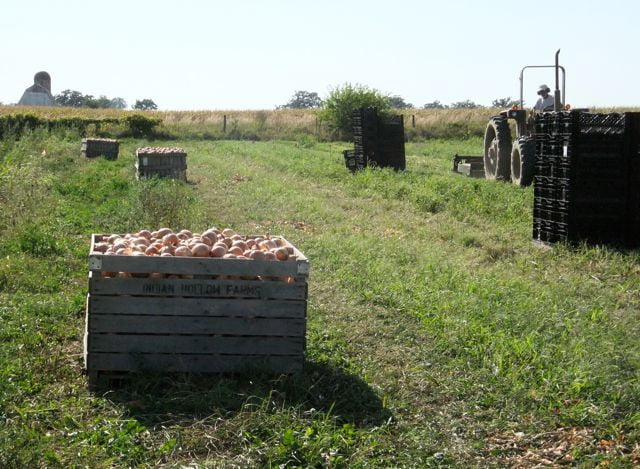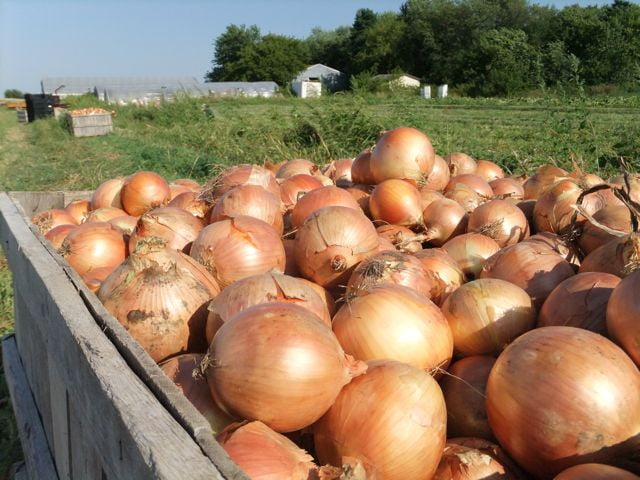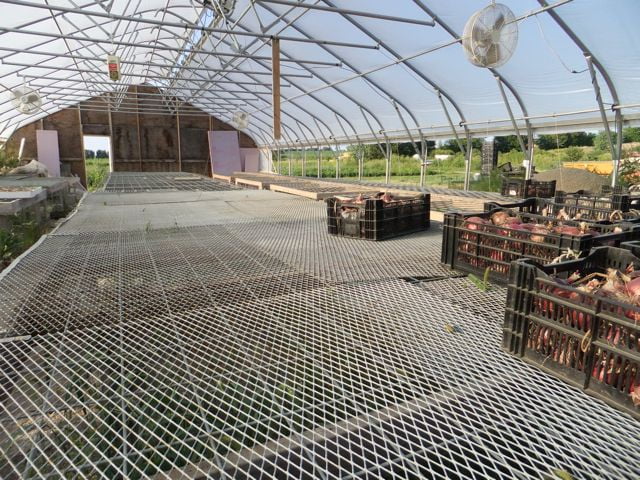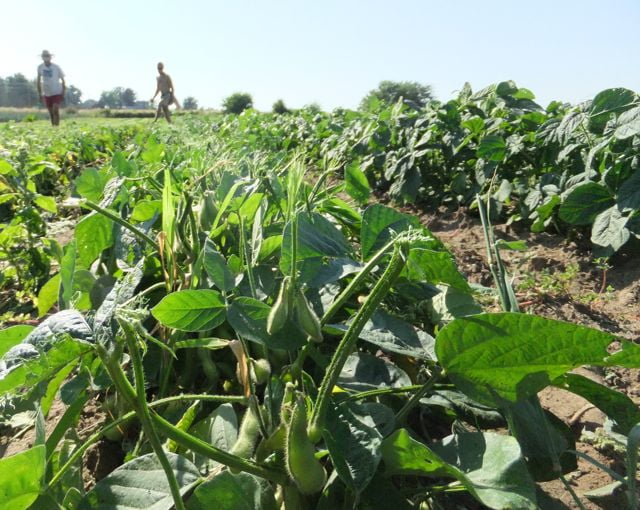Don’t need medicine to cure these onions
- On: August 28, 2013
 0
0
We found two ways to save effort this week. It was an unusually hot and busy week, and both changes were welcomed by our work crew.
The recent dry weather has allowed us to cure our onions in the field instead of hauling them to the greenhouse. Their growth is finished and the leaves have dried down. At harvest, we pull the onions out of the ground and leave them on the soil surface for a few hours to wither the roots. Usually, we pile them into shallow black crates, then haul them into the greenhouse to dry completely, then carefully transfer them into big wooden bins.
Onions are heavy, right? Skipping the greenhouse step saved so much effort. The onions look good. I hesitate to write that after 80% of the crop rotted last year. Let’s keep our fingers crossed.
After curing for several days in the field, the onions went straight into wooden bins for storage. On the right side of the field are stacks of plastic crates for gathering onions during harvest. Steve mows weeds now that the onions are collected.
The yellow onions sized up nicely this year. We’ll send this type after the shorter-season Walla Walla and white onions are done.
The greenhouse is almost empty right now. Usually every bench is filled with curing onions.
For our second innovation this week, Steve mowed the tops off our edamame plants before harvest. We usually chop them off with a machete. The pods set beautifully in a dense clusters at the base of the plants, allowing Steve to mow the leaves without damaging the pods.
Each simple change was appreciated by our work crew during a hot and busy week.
Edamame plants just before harvest. You can see the mowed, feathered tops of the plants in this row. The row to the right is unmowed.
Veggie List and Veggie Notes
1 melon (watermelon OR crenshaw OR honeydew)
sweet corn, probably 6 ears
edamame (edible soybeans), 1 bundle
slicing tomatoes, 5 lb
Walla Walla onions, 1 or 2
Romano beans, 0.75 – 0.85 lb
bell pepper, 1
cherry tomatoes, 1 pint
basil, 2 sprigs
One site will get an heirloom tomato.
Next week’s box will probably contain melon, sweet corn, tomatoes, peppers and more.
Melon – Most members will get a red watermelon this week but a few sites will receive crenshaw or honeydew. Here’s some extra info on those two types. Both are specialty melons that Steve tinkers with each year so our harvests are limited.
Crenshaw melons (Outpost or Basics co-ops; oblong with yellow rind and pale orange flesh) – These melons look like muskmelons inside but have a different flavor. They’ve been excellent this year. Ready to eat.
Honeydew melons (Basics only; white rind with pale green or white flesh) – These melons need to ripen at room temperature for two days before eating.
Edamame (bundle of stems with leaves and pods) – These edible soybeans are a treat. Pull the pods from the stem and wash well. It helps to submerge the pods and rub them together. Boil in water until the pods have split and the beans are quite tender. Season with salt and pop the beans out of the pods into your mouth. This Japanese specialty is becoming more and more popular in the USA. Storage: Remove the pods from the stems promptly and refrigerate.
Cherry tomatoes – We picked a variety of colors but everyone will receive some pink or some Black Cherry tomatoes. These two varieties are our favorites right now, so we wanted to share with everyone.
Heirloom tomatoes (large tomato that’s not in the bag with other tomatoes) – The heirloom tomatoes are just beginning to ripen. If you receive one this week, please handle it gently. These fragile beauties bruise easily. You might have to ripen your heirloom tomato at room temperature for a day or two. Don’t let it get overripe.







